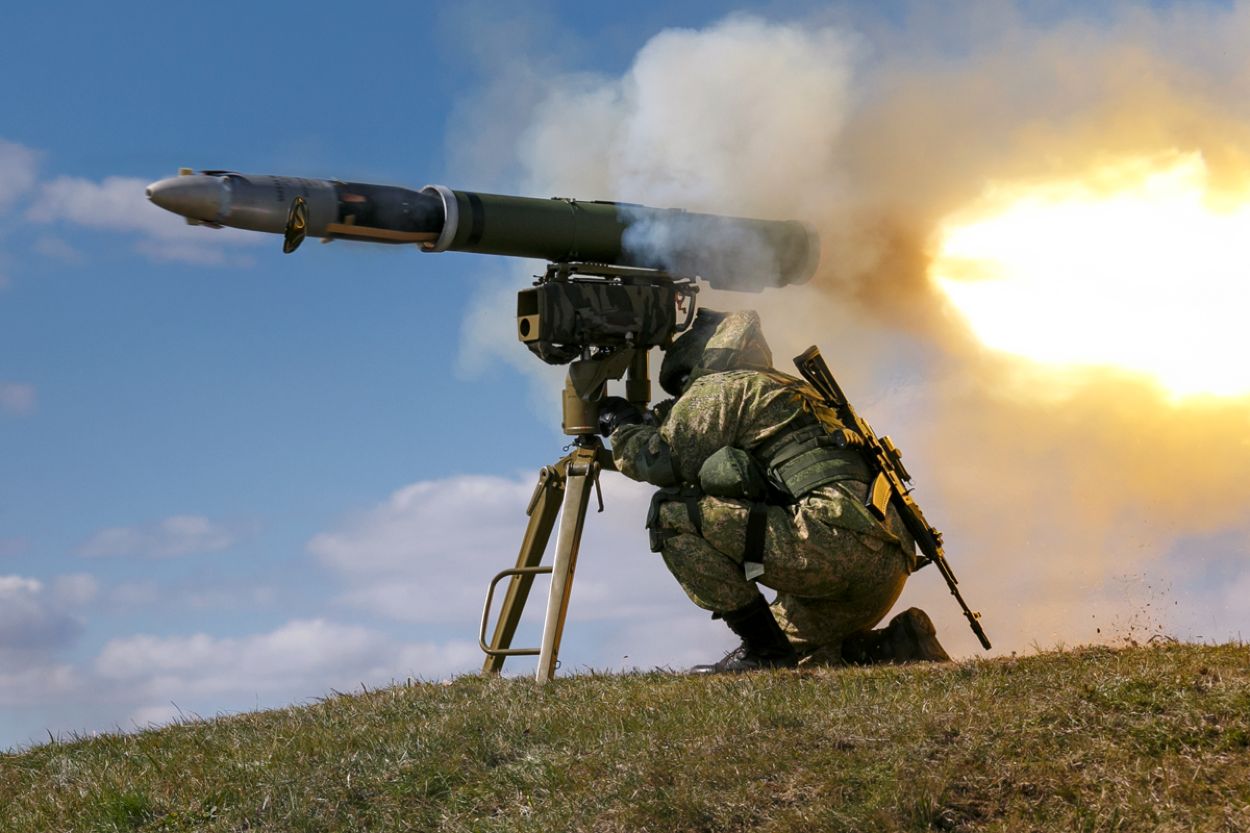Russia is using civilian truck-mounted elevators as raised platforms to fire anti-tank guided missiles (ATGM) at Ukrainian targets. This helps increase the missile’s range, bringing many targets within reach.
Angry Armenia To Arm Ukraine With Tochka-U Ballistic Missile System As Ties With Russia Decay – Reports
Videos posted on Telegram groups suggest it is not an uncommon practice on the frontline to have the range capability of ATGM-firing attack helicopters. ATGMs have been employed not only for destroying tanks but also for hitting groups of enemy soldiers in an anti-infantry role.
All-Terrain Vehicle (ATV)-mounted teams of Russian Airborne Troops behind the defensive lines undertake patrols and fire the missiles at Ukrainian troops trying to breach the defenses.
ATGMs have been predominantly used by the heavy-class Kamov Ka-52 Alligator/Hokum attack helicopter for destroying armor. The aircraft fired the Vikhr ATGM at ranges of 7 kilometers and beyond toward Ukrainian tanks, being responsible for a massive share of its tank losses during its failed counteroffensive this summer.
From the videos and the posts of the various military correspondents on Telegram, it appears that the mechanism is not used frequently but rather at select times when Ukrainians are probing for gaps and breaches in the defensive lines. Other posts suggest the arrangement is a substitute when Kamovs are engaged elsewhere.
Kornet ATGM On Truck-Mounted Elevator
A video posted by Telegram Group Voeancher showed a regular truck carrying a folding and extendable elevator mount rising just above the tree tops, with a metallic frame providing a small cubicle. A long tube can be seen protruding out of the frame, which the post identifies as a Kornet ATGM.
“One of the most popular things at the front is an aerial platform with the ability to plant a soldier with a Kornet ATGM there. The military-industrial complex and Moscow Region, let’s do something like this in series?”
The commentator is asking for the Russian defense industry to mass produce such elevated mounts, which can have multiple applications on the battlefield — from surveillance to placing small radars or even communications relay devices if the tactical situation allows for it.
However, the Telegram channels of RIA Novosti military correspondents Alexander Kharchenko and Sergei Shilov shed more light on the thinking behind employing such elevators.
A direct translation of their post in Russian said: “On the front line, I have repeatedly seen towers similar to hunting stands. At the right moment, anti-tank systems are raised there and destroy the enemy.
“An ATGM with a lifting mechanism is only an interim solution. At the front, they are waiting for a copter capable of carrying a Kornet. This Wunderwaffe should not cost that much, but it will have a lot of benefits. In particular, it will be able to perform the lion’s share of the Ka-52’s work.
“Still, it is better to care for such an expensive helicopter, giving the right to work to soulless machines.”
This means other such elevators have been used elsewhere on the frontline with the same purpose of doubling up as an extended-range ATGM launch platform when a helicopter is unavailable.
‘More Elevator Mounts’
The journalists, however, suggest that instead of increasing the production or employment of Ka-52 Alligators, they should make such cheap elevators in more significant numbers.
#Russia is using civilian truck-mounted elevators as raised platforms to fire anti-tank guided missiles (ATGM) at #Ukrainian targets. This helps increase the missile's range, bringing many targets within reach. #UkraineWar pic.twitter.com/1yebVllNJQ
— EurAsian Times (@THEEURASIATIMES) November 21, 2023
This is implied in the “soulless machines” terms used to describe the elevators, representing simple contractions that do not have technically sophisticated tasks or engineering yet effectively fulfill many elementary functions that take the load of more giant platforms.
Employing sophisticated platforms like the Ka-52 Alligator for a relatively simple task like destroying a singular enemy armor or target would be cost-to-benefit wise and logistically disadvantageous.
The helicopter carries eight Vikhr ATGMs and is more suited in situations where salvo fires are required on a large group of tanks or rapidly tracking and destroying multiple targets spread out in the same general area.
Platforms like the raised elevator or the ATV-mounted ATGM-firing troops can handle a single target that does not require heavy suppression.

The elevators’ only vulnerability can be First-Person View (FPV) drones that both sides have used effectively. Ukraine pioneered their employment initially with a devastating impact on Russian troops until Moscow caught up after its state-run defense industry and private technology and drone companies hiked production.
The commercial drones-turned-loitering munitions can easily spot such an elevator rising above the tree line and can merely fly into it before being detected.
Russian planners, meanwhile, would have to decide if they can allocate funds to the military to contract such civilian extendable elevators or specially design such truck-mounted machines.
- The author can be reached at satamp@gmail.com
- Follow EurAsian Times on Google News




